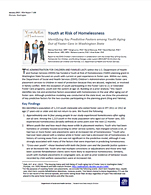Identifying Key Predictive Factors among Youth Aging Out of Foster Care in Washington State
This report identifies key risk and protective factors associated with homelessness in the year after aging out of foster care. Approximately one-quarter of the 1,213 youth statewide who aged out of foster care in SFY 2011 or 2012 experienced homelessness in the following year. Youth who had experienced housing instability, multiple school changes, or more than one foster care placement were at increased risk of homelessness. Cross-over youth—those involved with both the foster care and juvenile justice system—were also at increased risk. In terms of protective factors, youth who had ever been placed with a relative while in foster care and those with relatively high grade point averages were at decreased risk of homelessness.
Report and/or Additional Information:
Categories:
Related Publications:
- 2012 Foster Parent Survey (11.188)
- 2013 Foster Parent Survey (11.207)
- 2014 Foster Parent Survey: DSHS Foster Parents Speak (11.215)
- 2015 Foster Parent Survey: DSHS Foster Parents Speak (11.227)
- 2016 Foster Parent Survey: DSHS Foster Parents Speak (11.239)
- 2017 Foster Parent Survey: DSHS Foster Parents Speak (11.243)
- 2018 Foster Parent Survey: DCYF Foster Parents Speak (11.246)
- 2019 Caregiver Survey Report (7.118)
- 2020 Caregiver Survey Report (7.123)
- 2021 Caregiver Survey Report (7.125)
- 2022 Caregiver Survey Report (7.126)
- 2023 Caregiver Survey Report (11.270)
- 2024 Caregiver Survey Report (7.127)
- A Profile of Housing Assistance Recipients in Washington State by Household Type (11.166)
- A Profile of Housing Assistance Recipients in Washington State: History of Arrests, Employment, and Social and Health Service Use (11.160)
- Achieving Successful Community Re-Entry upon Release from Prison (11.193)
- Alcohol and/or Drug Problems and Mental Illness are Key Risk Factors for Homelessness among Working-age Disabled DSHS Clients (3.33)
- Bringing Recovery into Diverse Groups through Engagement and Support (4.100)
- Bringing Recovery into Diverse Groups through Engagement and Support (4.93)
- Bringing Recovery into Diverse Groups through Engagement and Support (4.97)
- Changing Support Needs Among Adults Experiencing Homelessness: Washington State Apple Health Clients, 2019-2023 (11.277)
- Characteristics and Service Use of Young Adults in Extended Foster Care (11.266)
- Characteristics of Housing Assistance Recipients from Three Public Housing Authorities (11.204)
- Characteristics of Public Housing Assistance Recipients in Washington State (11.223)
- Children's Services Needs Assessment (7.21a)
- Education and Well-Being of Children in Assisted Housing Programs (11.238)
- Employment Outcomes Associated with Rapid Re-housing Assistance for Homeless DSHS Clients in Washington State (11.185)
- Family Foster Care Update (7.26)
- Foster Care Expenditures Study (7.66)
- Homeless and Unstably Housed K-12 Students in Washington State (11.214)
- Homeless Families in Washington State. A study of Families Helped by Shelters and Their Use of Welfare and Social Services (11.98)
- Homeless Families with Children Receiving Welfare Assistance in Washington State (6.47)
- Homelessness Among Youth Exiting Systems of Care in Washington State (11.254)
- Housing Service Disparities Among Adults Experiencing Homelessness in Washington State (11.276)
- Housing Status of Youth Exiting Foster Care, Behavioral Health and Criminal Justice Systems (11.240)
- Identifying Homeless and Unstably Housed DSHS Clients in Multiple Service Systems (11.169)
- Impact of Homelessness on Youth Recently Released from Juvenile Rehabilitation Facilities (11.191)
- Impact of Housing Assistance on Outcomes for Homeless Families (11.219)
- Impact of Housing Assistance on Short-Term Homelessness (11.165)
- Impacts of Permanent Supportive Housing Services (11.233)
- In-Home Service Use and Family Risk for Child Welfare Involved Families: Findings from Washington State (7.116)
- Independent Living Services for Foster Care Youth (11.183)
- Independent Living Services for Foster Youth (7.111)
- Informing the Placement Continuum: Classifying Children in Out-of-Home Placement Using Integrated Administrative Data (7.124)
- Permanent Options for Recovery-Centered Housing (11.199)
- Permanent Options for Recovery-Centered Housing (PORCH) (11.218)
- Permanent Options for Recovery-Centered Housing: Year 1 Annual Report (11.171)
- Persons Served by Washington State Housing Assistance and Social Service Programs (11.147)
- Predicting Homelessness among Emerging Adults Aging Out of Foster Care ()
- Predicting Homelessness among Low-Income Families on TANF (11.224)
- Pregnant and Parenting Youth in Foster Care in Washington State: Comparison to Other Teens and Young Women who Gave Birth (11.202)
- Spokane Better Health through Housing: A Pilot Program Connecting Homeless High Emergency Department Utilizers to Housing (11.257)
- Substance Use Disorder Treatment Penetration among Child Welfare-Involved Caregivers (7.121)
- The Ending Family Homelessness Pilot: Rapid Re-Housing for TANF Families (11.203)
- The Foundational Community Supports Program: Preliminary Evaluation Findings (11.251)
- The Housing Status and Well-Being of Youth Aging Out of Foster Care in Washington State (11.195)
- The Housing Status of Individuals Discharged from Behavioral Health Treatment Facilities (11.170)
- The Housing Status of Individuals Leaving Institutions and Out-of-Home Care (11.200)
- The Impact of Forensic Housing and Recovery Through Peer Services (FHARPS) on Homelessness and Housing Support Access – An Outcome Evaluation (11.274)
- The Impact of Recent Policy Changes on Outcomes for Medical Care Services Clients (11.187)
- Transition to Adulthood (7.104)
- Transition to Adulthood: Foster Youth at 19 (7.107)
- Transition to Adulthood: Washington State Foster Youth at Age 17 (7.108)
- Washington State's Fostering Well-Being Program: Impacts on Medical Utilization (9.105)
- Washington State’s Housing and Essential Needs Program (11.186)
- What Data Should We Gather About Homeless Families in Washington State (6.50)
- Youth Aging Out of Foster Care (7.109)

